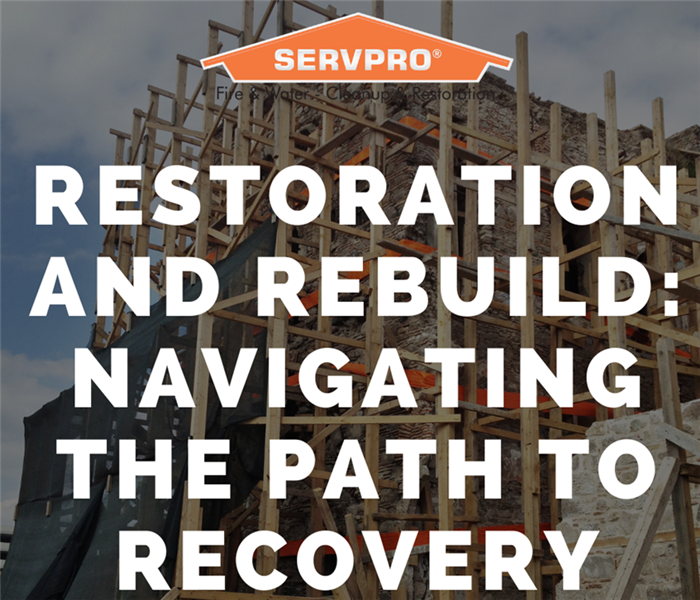Restoration and Rebuild: Navigating the Path to Recovery
10/5/2024 (Permalink)
When disaster strikes, whether it’s a fire, flood, or another unexpected event, the process of restoring and rebuilding can be overwhelming in Bellingham, MA. However, understanding the key steps and what to expect can help make the journey from damage to recovery smoother and less stressful. Here’s a comprehensive guide to navigating the restoration and rebuild process.
1. Understanding the Restoration Process
Restoration is the first step in recovering from damage. It focuses on returning your property to a safe, livable condition and involves several crucial stages:
- Assessment: The process begins with a thorough inspection of the damage. Professionals will evaluate the extent of the destruction and determine the necessary steps for restoration. This assessment often includes identifying any safety hazards and determining the structural integrity of the property.
- Mitigation: This stage involves taking immediate action to prevent further damage. For example, in the case of water damage, this may include removing standing water and drying out affected areas to prevent mold growth. In the event of a fire, this could mean boarding up windows and securing the property.
- Cleaning and Sanitizing: Once the property is secured, the next step is to clean and sanitize the affected areas. This includes removing debris, cleaning surfaces, and addressing any contamination issues. Specialized equipment and cleaning agents are often used to ensure thorough restoration.
- Restoration: With cleaning complete, the restoration process involves repairing and replacing damaged structures and materials. This may include drywall, flooring, and cabinetry. The goal is to return the property to its pre-damage condition as closely as possible.
2. The Rebuild Process: What to Expect
Rebuilding is the phase where you restore the property to its original state or even enhance it. This process can be more complex and involves several key steps:
- Design and Planning: A detailed plan must be created before any physical work begins. This includes designing the layout, selecting materials, and obtaining necessary permits. Working with a qualified contractor or architect can help ensure that the design meets your needs and adheres to local building codes.
- Demolition and Removal: If the damage is extensive, some parts of the property may need to be demolished and removed. This step must be handled carefully to ensure that it does not impact the structural integrity of the remaining parts of the building.
- Reconstruction: The reconstruction phase involves rebuilding the damaged or demolished areas. This may include framing, installing new drywall, and setting up electrical and plumbing systems. It’s essential to work with experienced professionals to ensure that the work is done correctly and meets all safety standards.
- Finishing Touches: Once the major construction work is completed, finishing touches are added. This includes painting, flooring, and installing fixtures. The goal is to make the property not only functional but also aesthetically pleasing.
3. Working with Insurance and Contractors
Navigating the insurance claims process and selecting the right contractors are crucial components of the restoration and rebuild process:
- Insurance Claims: Documenting the damage thoroughly and working with your insurance adjuster can help ensure that you receive the coverage you’re entitled to. Keep detailed records of all communications, estimates, and repairs.
- Choosing Contractors: Selecting reputable contractors is key to a successful rebuild. Look for professionals with experience in restoration and reconstruction, and check references and reviews. Make sure to get detailed written estimates and contracts to avoid misunderstandings.
4. Considerations for a Successful Restoration and Rebuild
- Timeline: Restoration and rebuild projects can take time. Be prepared for potential delays and keep communication open with your contractors and insurance adjuster.
- Budget: Managing your budget is essential. While it’s important to address all necessary repairs and upgrades, keep an eye on costs and be aware of any potential hidden expenses.
- Emotional Support: Dealing with the aftermath of a disaster can be emotionally challenging. Seek support from friends, family, or professionals to help manage stress and emotions during the recovery process.
5. Preventing Future Damage
Once the restoration and rebuild are complete, take steps to prevent future issues:
- Regular Maintenance: Keep up with regular maintenance to address potential problems before they become major issues.
- Disaster Preparedness: Develop a disaster preparedness plan for your home or business to mitigate the impact of future events. This can include creating an emergency kit, establishing communication plans, and securing important documents.
Restoration and rebuilding are significant undertakings that require careful planning and execution. By understanding the process, working with experienced professionals, and taking proactive steps, you can successfully navigate the path to recovery and restore your property to its full potential in Bellingham, MA
SERVPRO of Foxborough is your comprehensive solution for residential and commercial restoration and cleaning services. Our highly trained technicians are available 24/7 to address any water, fire, or storm damage in Franklin, MA | Millis, MA | Wrentham, MA | Foxborough, MA | Wethersfield, MA | Bellingham, MA | Norfolk, MA and surrounding areas.





 24/7 Emergency Service
24/7 Emergency Service
